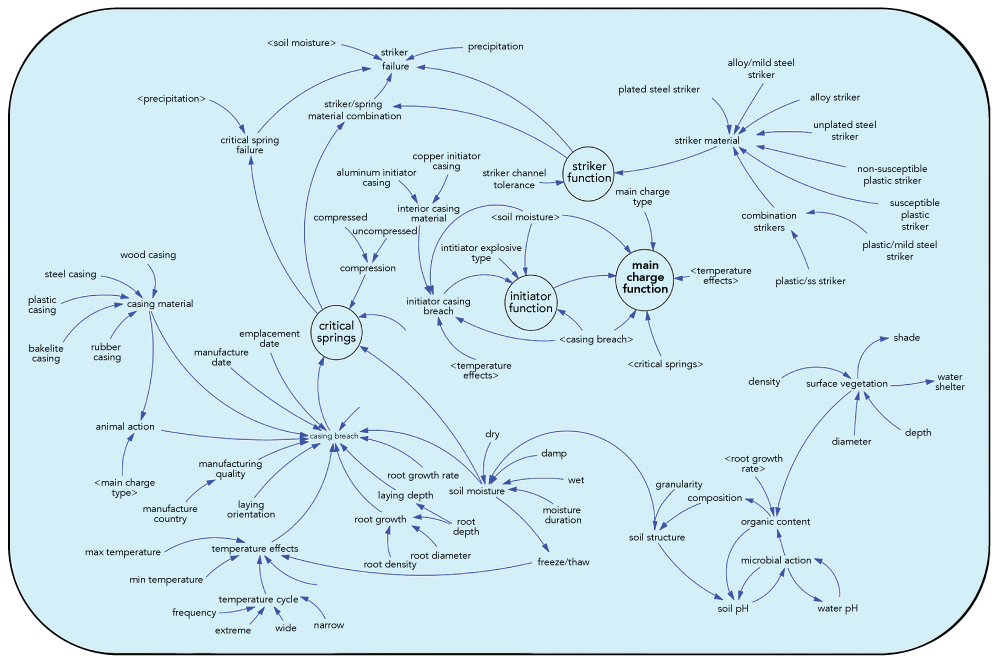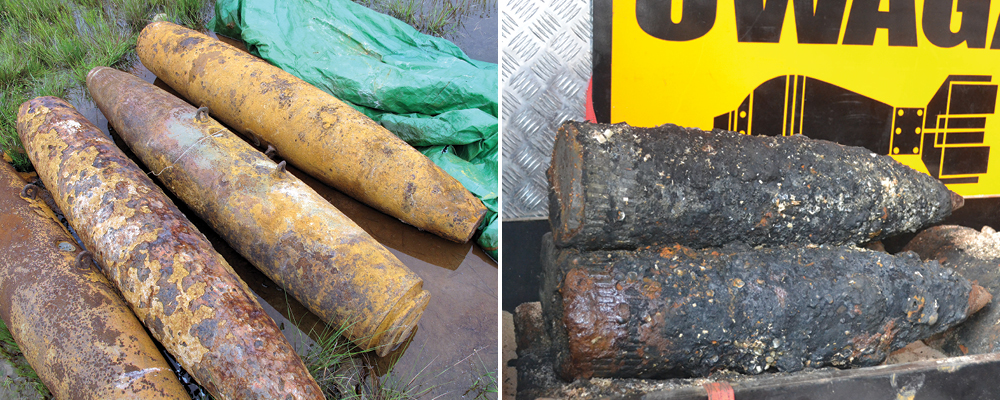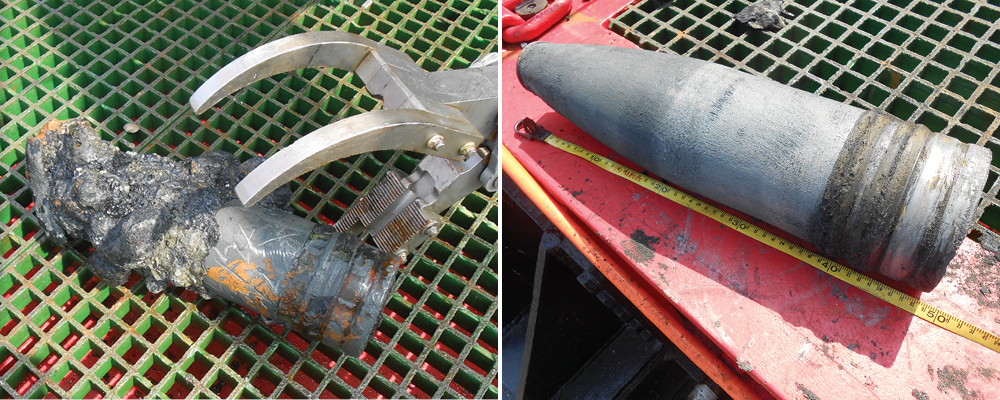Studying the Effects of Aging
on Ammunition Under Water
CISR JournalThis article is brought to you by the Center for International Stabilization and Recovery (CISR) from issue 28.2 of The Journal of Conventional Weapons Destruction available on the JMU Scholarly Commons and Issuu.com.
By Nicole Neitzey [ Center for International Stabilization and Recovery ]
and Colin King [ Fenix Insight ]
The world’s oceans and waterways contain untold amounts of munitions, whether dumped or fired, and the sometimes-harsh underwater environment can make their clearance difficult. Yet we are approaching a time when we will have to face the reality of removing them to continue enjoying the planet’s most abundant natural resource. Much of the ammunition in areas from the Baltic Sea to the rivers of Cambodia to the Gulf of Mexico has been immersed for decades, subject to a variety of underwater influences. Many studies have examined the impacts of degrading explosives on the surrounding environment, but few look at what effect the environment has on the munition. The study seeks to analyze those effects and their varied implications.
Background
Worldwide, oceans and waterways are contaminated with untold amounts of munitions, many having been dumped when deemed no longer useful, and some having been fired during active conflict or live training exercises. Munitions under water pose a potential threat to commercial operations, civilians engaging in recreational activities, and the health of various underwater ecosystems. Clearance of these hazards is complicated by the realities of operating in difficult circumstances requiring special equipment and training and by the assortment of clutter found in different underwater environments. Yet the recognition that the world’s oceans, rivers, and lakes have great resources to offer and the realization that the sometimes-forgotten munitions that lie in their depths are standing in the way of harnessing the full benefit of these resources while also affecting the health of these ecosystems, means that the time is coming when their clearance will be imperative. Much of the ammunition in these areas has been immersed for decades, subject not only to the effects of water, but also to a variety of other influences present in the underwater environment, such as temperature, pressure, biological content, and even human interaction. Another category of factors that can impact munition aging under water is something referred to in the study as “predisposition to aging,” which is a series of internal and external characteristics related to the munition that may either promote or inhibit the aging process. The combination of these “predisposition influences” explains why similar types of ammunition, in comparable environments, can exhibit varied behaviors during aging. These factors include the materials and design of the munition as well as the circumstances of its storage, maintenance, and deployment (See Figure 1 for a sampling of the various factors at play in munition aging.) When these munitions enter the water after being fired, their condition is already uncertain due to the unknown reasons for failure during deployment; this is further complicated by the effects of aging in these conditions.
Environmental impacts on munitions have been anecdotally observed for a number of years, yet the measurable effects of ammunition aging have not been fully quantified; as a 2019 report from the Geneva International Centre for Humanitarian Demining (GICHD) indicates, “most information on ageing is anecdotal, rather than systematically compiled.”1 In a 2008 article, explosive ordnance disposal (EOD) consultant Colin King wrote “it has long been understood that time and environment take a toll on munitions.”2 Six years earlier, two studies for the US Army Environmental Center attempted to describe corrosion of landmines/unexploded ordnance (UXO) and the factors influencing it to better understand how these effects might apply in particular to UXO on sites in the United States and their potential environmental impacts.3,4 Numerous studies, in fact, have tried to quantify the impacts of degrading explosives on the surrounding environment5,6,7 but few look at the issue from the opposite perspective of what effect the environment has on the munition.
Data on the underwater effects of aging on these systems is limited, leading to polarized views among EOD personnel and risk managers. Changes due to aging lead to greater uncertainty, which implies increased risk; this in turn requires greater caution, with knock-on implications for resources, time, and cost. In a keynote at Kiel Munition Clearance Week 2021, Chief of the German Navy, Vice Admiral Kay-Achim Schönbach, reported that some of the legacy munitions they are finding are no longer safe to handle due to the aging process.9 However, land-based research has established that munitions generally become safer as they degrade. In Denmark, for example, it was found that World War II-era mines being cleared sixty years after emplacement had been nonfunctional for some time if they were in contact with salt water, “due to the alteration of explosives in the detonators from their interaction with salt water and the degradation and corrosion of fuzes.”10 The reality, however, is that different mechanisms, materials, and explosives will react to long-term immersion in different ways, requiring further study to determine how different munitions are impacted by different environments and what the implications are for safety and efficacy of clearance efforts.
The Study—Purpose and Methods
In 2022, the Center for International Stabilization and Recovery (CISR) at James Madison University (JMU) joined with explosives experts from Fenix Insight to observe and characterize the visual, structural, and functional changes that occur when munitions are submerged for long periods. The purpose of the study was to provide a broad overview of impacts that aging in underwater settings can have on submerged munitions, serving as a means to identify the residual risk these munitions pose.
JMU faculty with scientific backgrounds in chemistry, physics, geology, biology, and environmental and materials sciences lent their expertise to the project in the form of a research advisory board to help the team better understand the scientific explanations behind the physical and chemical effects being observed, as well as their potential implications. The US Department of Defense’s Strategic Environmental Research and Development Program (SERDP) has funded this work and thus it is focused on the implications for cleanup of US military testing and training facilities, but its findings can also inform the work of the humanitarian sector involved in explosives remediation. The full report is expected to be published by mid-2024 and will be available on the CISR website.11

This study predominantly focused on ammunition used during testing or training that failed to function as designed, which is categorized as UXO. Other explosive ordnance (EO), whether derived from stockpiles, sunken cargo vessels, or historic disposal programs like sea dumping, is classified as abandoned explosive ordnance (AXO). This distinction is important in that UXO and AXO exhibit critical differences in their conditions and associated risks (see Figure 2). UXO, typically being fully fuzed, frequently armed, and often subjected to impact, usually brings a high level of uncertainty due to the unknown reasons for its failure and the type and degree of damage sustained. In contrast, AXO, mostly being unfuzed, unarmed, and not subjected to impact, has much less uncertainty associated with it.
The team consolidated and reviewed existing data on the aging of land-based ammunition to make logical predictions for their application to the underwater environment. Patterns of deterioration in casing materials, mechanisms, and explosive compositions were investigated to make educated predictions for future comparisons. The team also relied on its own prior work studying the effects of time and environment on land-based ordnance.12 Some of those previous studies involved the complete disassembly and analysis of live ammunition,13 along with preliminary studies and risk assessment. The ability to visualize, examine, and test internal structures proved invaluable, with some of the observed effects being undoubtedly transferrable to the underwater environment. Thus, imagery and data from those studies have informed this investigation.
Findings
This study has reached the following key conclusions:
- Limited information. Relatively little is known about the effects of aging on munitions spending prolonged periods under water, largely due to policies of either leaving these munitions undisturbed in place or destroying in situ.
- Predictability. The many influences in the underwater environment, with their potential interactions creating a vast number of permutations, make it extremely difficult to predict effects and outcomes with any accuracy (see Figure 1).
- Problematic research. One reason so little information exists is that practical research in this area is potentially hazardous. This is true but, ironically, is a self-reinforcing barrier to gaining greater clarity.
- AXO and UXO. AXO is usually unfuzed, unarmed, and undamaged when it is abandoned. It therefore involves far less uncertainty than UXO, which is often armed, damaged, and may have been subjected to extreme forces during deployment and impact.
- Trend toward failure. Munitions inevitably progress from fully functional to being incapable of functioning as designed, starting with the failure of one or more key components until they eventually become fully inert.
- Non-functional does not equal safe. The fact that a munition may be incapable of functioning as designed does not necessarily make it safe. So long as explosive material is present, it continues to pose potential risk.
- External impetus. In most cases, the net effect of fuze failure is to increase the energy threshold for initiation. While this threshold may no longer be available from, or exceeded by, the fuzing system, it could be provided by an external source, such as violent impact or intense heat.
- Unintended mechanisms. Deterioration can lead to unintended initiation mechanisms through chemical reactions, physical changes, or both, temporarily increasing the risk of accidental or spontaneous detonation.
- Climate change. Changing environmental factors, such as the acidification of seawater, increased water temperature, and increases in storm intensity, may become significant. In particular, the chances of ammunition suddenly becoming exposed to air appear to be increasing.
- Exposure to air. When ammunition is washed up on land or otherwise exposed to air, the substantial change of environment could exacerbate the creation of unintended mechanisms. This includes the possible reversal of effects that had resulted in non-functionality.

Implications and Other Considerations
Aging effects may significantly alter the appearance and physical characteristics of munitions, which could have important implications for their visual recognition (see Figure 3), as well as for emerging detection and identification technologies. In many cases, the deterioration of ammunition will degrade these capabilities and hamper clearance efforts. A better understanding of aging effects is therefore important to the preliminary stages of ordnance location, as well as its eventual disposal.

A notable phenomenon unique to the underwater environment is that of concretion on munitions (i.e., the buildup of marine encrustation on items submerged for long periods). This buildup can significantly alter the ordnance’s appearance, which hinders visual detection and recognition, and may also degrade the performance of sensor-based detection technology trained to look for particular signatures. Additionally, it may provide a layer of insulation from the surrounding environment that—counterintuitively, based on the munition’s appearance—could actually slow any aging effects (see Figure 4).

The report focuses mainly on the risk of accidental initiation, as people or equipment interact with submerged munitions during activities like clearance, construction, and leisure pursuits. Yet other risks, such as environmental contamination, clearly co-exist.
Recommendations
This study has confirmed that there is relatively little awareness or understanding surrounding the effects of aging on ammunition underwater. To address this lack of knowledge, the community should focus greater attention on the subject, which can be done through communication of these issues to key stakeholders (such as funders, clearance operators, affected populations, researchers, and equipment developers), as well as their coordination and cooperation on these issues, plus further targeted research, including detection trials using aging inert ammunition. The study team also encourages the community to engage in more systematic data collection when encountering underwater ordnance, so long as it is safe to do so. Capturing images and observations about the environment and the munitions themselves can greatly increase the body of knowledge surrounding this subject and enhance our understanding of issues relating to prioritization, identification, detection, disposal, safety, and cost efficiency in underwater clearance operations. Sharing reports on remediation efforts in underwater environments, as well as information on accidents or incidents involving underwater munitions, is also welcome. Any data collection on the topic should of course be conducted in accordance with the guidance in IMAS 07.11.14 If you have information to share, please contact the research team at cisr@jmu.edu.
See endnotes below.
 Nicole Neitzey is the Assistant Director at the Center for International Stabilization and Recovery (CISR) and acts as program manager/grants officer. She graduated from James Madison University (JMU) in 2002 with a bachelor of arts in technical and scientific communication, and a specialization in online publications and earned a master of public administration (MPA) from JMU in 2015 with a concentration in nonprofit management. She has worked for CISR since 2001, and since 2016, has taught an MPA course on Proposal Writing and Project Management.
Nicole Neitzey is the Assistant Director at the Center for International Stabilization and Recovery (CISR) and acts as program manager/grants officer. She graduated from James Madison University (JMU) in 2002 with a bachelor of arts in technical and scientific communication, and a specialization in online publications and earned a master of public administration (MPA) from JMU in 2015 with a concentration in nonprofit management. She has worked for CISR since 2001, and since 2016, has taught an MPA course on Proposal Writing and Project Management.
 Colin King served in the British Army as an explosive ordnance disposal (EOD) officer, instructor, and intelligence analyst, with numerous operational tours. He also wrote EOD reference works for Janes for seventeen years. Now Chief Intelligence Officer for Fenix Insight, his work includes the disassembly and analysis of unexploded and abandoned ordnance around the world.
Colin King served in the British Army as an explosive ordnance disposal (EOD) officer, instructor, and intelligence analyst, with numerous operational tours. He also wrote EOD reference works for Janes for seventeen years. Now Chief Intelligence Officer for Fenix Insight, his work includes the disassembly and analysis of unexploded and abandoned ordnance around the world.

